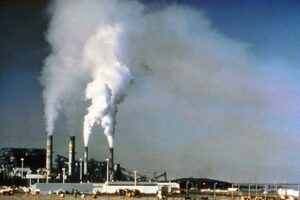5 Types of Greenhouse Gases Explained
Types of greenhouse gases are; carbon-bearing, non carbon-bearing, naturally-emitted, industrial, and agricultural greenhouse gases.
They are classified based on composition and sources. It must be noted that types of greenhouse gases differ from examples of greenhouse gases that include carbon dioxide, methane and water vapor.
This article discusses the types of greenhouse gases, as follows;
1). Carbon-bearing GHGs (as one of the Types of Greenhouse Gases)
Carbon is a very important and versatile element in greenhouse gases.
The main sources of carbon in greenhouse gases are organic materials like biomass (plant and animal matter) and fossil fuels [1]. These materials release carbon-bearing greenhouse gases into the environment when they breakdown either as a result of biodegradation or combustion.
The role of carbon in the greenhouse effect is compositional and absorptive, so that traces of carbon in greenhouse gases make these gases capable of absorbing and retaining significant amounts of heat or solar radiation close to the Earth's surface.
Examples of carbon-bearing greenhouse gases are; carbon dioxide (CO2), methane (CH4), hydroflurorocarbons (HFCs) and hydrochlorofluorocarbons (HCFCs).
Of these, carbon dioxide is most prominent as a greenhouse gas emitted as a result of human activities like deforestation, regional urbanization, transport, manufacturing and electricity generation [4].
Effects of carbon dioxide on the ecosystem extend beyond the typical greenhouse effect, to include acid rain formation and rock dissolution.
Hydrochlorofluorocarbons and hydrofluorocarbons are manmade greenhouse gases that are used mainly as commercial and domestic refrigerants [5]. In addition to their contribution to greenhouse effect, these gases also cause ozone layer depletion which is another hazardous factor behind global warming.
Carbon plays a role in environmental pollution of various kinds; including oil spills, ocean pollution, and air pollution by particulate matter.
2). Non Carbon-bearing GHGs
Non carbon-bearing GHGs are greenhouse gases whose chemical composition does not include any significant amounts of carbon.
These greenhouse gases can be emitted from agricultural fertilizer, mines, chemical effluents, and power plants.
Examples of non carbon-bearing greenhouse gases are; nitrous oxide (N2O), water vapor (H2O), ozone (O3), sulfur hexafluoride (SF6), and nitrogen trifluoride (NF3).
3). Naturally-emitted GHGs (as one of the Types of Greenhouse Gases)
Naturally-emitted GHGs are those greenhouse gases that are released into the environment as a result of natural processes, without any significant human influence.
There are at least five (5) natural greenhouse gases that include; methane, carbon dioxide, nitrous oxide, ozone, and water vapor.
The most common natural greenhouse gas is carbon dioxide; which is produced by respiration, and microbial decomposition of organic matter in natural ecosystems like forests.
4). Industrial GHGs
Industrial GHGs are manmade or anthropogenic greenhouse gases whose emission can be traced to any of various industrial activities.
Industries constitute a major source of greenhouse gases, so that over 40% of global carbon dioxide and over 20% of total emissions have been known to come from the industrial sector [3].
The various categories of industrial greenhouse gases include those from manufacturing, energy resource exploration and exploitation, recycling, transportation, forest management and food processing.
Most synthetic greenhouse gases are produced and emitted from industrial activities.
Four examples of industrial greenhouse gases are; hydrofluorocarbons, nitrogen trifluoride, sulfur hexafluoride, perfluorocarbons.
Practices like carbon capture, renewable energy development and sustainable manufacturing have been implemented to reduce industrial greenhouse gas emissions.

5). Agricultural GHGs (as one of the Types of Greenhouse Gases)
Agricultural GHGs are anthropogenic greenhouse gases that are emitted as a result of agricultural activities.
Although they can be categorized under industrial GHGs, agricultural gases must be also evaluated separately because of their magnitude; and the importance of agriculture itself to human survival.
The amount of greenhouse gases that are from agricultural activities is about 11% as of 2020.
Of all agricultural activities, livestock farming is particularly involved in the emission of carbon dioxide and methane.
Measures have been deliberated as well as implemented to reduce greenhouse emissions from the agricultural sector [2]. These measures can be summarized as the practice of sustainable agriculture.

Conclusion
Types of greenhouse gases are;
1. Carbon-bearing GHGs
2. Non Carbon-bearing GHGs
3. Naturally-emitted GHGs
4. Industrial GHGs
5. Agricultural GHGs
References
1). Bessou, C.; Ferchaud, F.; Gabrielle, B.; Mary, B. (2011). "Biofuels, greenhouse gases and climate change." Sustainable Agriculture Volume 2 (pp.365-468). Available at: https://doi.org/10.1007/978-94-007-0394-0_20. (Accessed 2 February 2023).
2). Leahy, S.; Clark, H.; Reisinger, A. (2020). "Challenges and Prospects for Agricultural Greenhouse Gas Mitigation Pathways Consistent With the Paris Agreement." Frontiers in Sustainable Food Systems 4:69. Available at: https://doi.org/10.3389/fsufs.2020.00069. (Accessed 1 February 2023).
3). Moomaw, W. R. (1996). "Industrial emissions of greenhouse gases." Elsevier, Energy Policy Volume 24, Issues 10–11, October–November 1996, Pages 951-968. Available at: https://doi.org/10.1016/S0301-4215(96)80360-0. (Accessed 1 February 2023).
4). Satterthwaite, D. (2008). "Cities' contribution to global warming: Notes on the allocation of greenhouse gas emissions." Environment and Urbanization 20(2):539-550. Available at: https://doi.org/10.1177/0956247808096127. (Accessed 2 February 2023).
5). Xiang, B.; Patra, P. K.; Montzka, S. A.; Miller, S. M.; Elkins, J. W.; Moore, F. L.; Atlas, E. L.; Miller, B. R.; Weiss, R. F.; Prinn, R. G.; Wofsy, S. C. (2014). "Global emissions of refrigerants HCFC-22 and HFC-134a: unforeseen seasonal contributions." Proc Natl Acad Sci U S A. 2014 Dec 9;111(49):17379-84. Available at: https://doi.org/10.1073/pnas.1417372111. (Accessed 2 February 2023).

